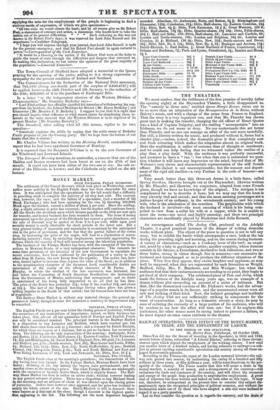An extravaganza called The Jockey Club, produced at the Adelphi
Theatre, is a good practical instance of the danger of writing dramatic works without plots. The object of the piece in question is not to tell any story, but to exhibit the bustle which accompanies a race, both at the inn during the preceding night and morning, and on the course during business. A variety of characters,—such as a Cockney lover of the turf; an exqui- site, acted by a lady in gentleman's attire; another exquisite, whose humour consists in his fatness; a Frenchman, destined to look ridiculous; and two or three ladies, strong in virtue though free in manners,—are successive in- troduced and interchanged B0 as to produce the different situations of the piece. When first they appear, they excite laughter and applause; as may well be supposed, when they are represented by such favourites as Wright, Bedford, Selby, Mrs. F. Matthews, and Miss Woolgar: but when the audience find that their embarrassments are tending to no point, they begin to get tired of their company. The celebrated piece of Tom and Jerry, which made the fortune of the Adelphi many years ago, was an example of a drama without plot succeeding on account of a series of tableaux. But that, like the dramatized versions of Mr. Dickens's works, bad the advan- tage of a popular mania in its favour, and the unconnected scenes were all new and striking of their kind. Now, the isolated groupings and incidents of The Jockey Club are not sufficiently striking to compensate for the want of construction. As long as a dramatist reveals a story, he may be sure of enlisting the curiosity of a large portion of his audience, who will be anxious to see how the affair will turn out: but if he neglects this incitement, his other means must be strong indeed to prevent a failure, or he must depend on some cause extrinsic to the theatre.


























 Previous page
Previous page